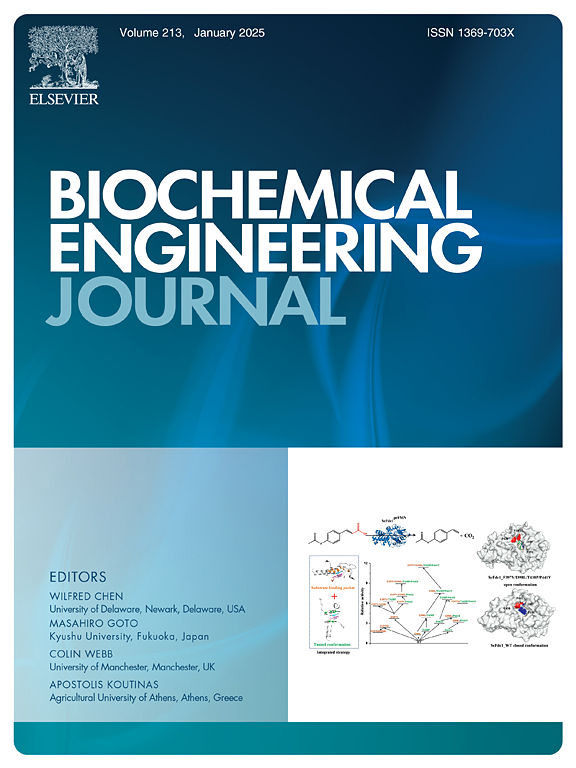Expressing and functionally evaluating anticancer bispecific antibody fragments using cyanobacterium Synechocystis sp. PCC6803 for sustainable production
IF 3.7
3区 生物学
Q2 BIOTECHNOLOGY & APPLIED MICROBIOLOGY
引用次数: 0
Abstract
Anticancer bispecific antibody (BsAb) fragments are effective therapeutic agents because of their high tissue penetration and cytotoxic effects, which can be produced in cost-effective bacterial hosts. We used the cyanobacterium Synechocystis sp. PCC6803 (PCC6803) as an alternative host for sustainably producing BsAb fragments from CO2. Cyanobacteria are sustainable and independent of external carbon sources such as glucose, because of producing substances via photosynthesis. Cyanobacteria can be cultured using wastewater or seawater, reducing freshwater consumption and the environmental impact of the process, suggesting that cyanobacteria can be used as a sustainable BsAb production platform. We examined the production of various antibody fragments, namely, single-chain bispecific diabody (scBsDb), single-chain fragment variable (scFv), variable domains of the heavy-chain antibody VHH, and bispecific tandem VHH (BsVHH), using PCC6803. scBsDb showed partial antigen-binding ability and no cytotoxic effects. In contrast, all scFvs and VHH had binding abilities and we prepared BsVHH up to 2.4 mg/L culture. BsVHH showed binding activity with the targets and cytotoxic effects against carcinoma, unlike scBsDb. Our results highlight the suitability of VHH and VHH-based engineered antibody fragments for using PCC6803 and indicate their potential for producing other therapeutic proteins. We report producing functional BsAb fragments using cyanobacteria. Our findings contribute to developing cyanobacterial bioprocesses for producing therapeutic BsAb fragments, expanding the possibilities for sustainably producing valuable materials from CO2.
利用聚胞蓝藻PCC6803表达抗癌双特异性抗体片段并对其进行功能评价
抗肿瘤双特异性抗体(BsAb)片段具有较高的组织穿透性和细胞毒性作用,是一种有效的治疗药物,可以在经济有效的细菌宿主中产生。我们使用蓝细菌聚囊藻sp. PCC6803 (PCC6803)作为从二氧化碳中可持续生产BsAb片段的替代宿主。蓝藻是可持续的,不依赖于葡萄糖等外部碳源,因为它们通过光合作用产生物质。蓝藻可以利用废水或海水进行培养,减少了淡水消耗和过程对环境的影响,表明蓝藻可以作为可持续的BsAb生产平台。我们使用PCC6803检测了各种抗体片段的产生,即单链双特异性糖尿病(scBsDb)、单链片段可变(scFv)、重链抗体VHH的可变结构域和双特异性串联VHH (BsVHH)。scBsDb具有部分抗原结合能力,无细胞毒作用。相比之下,所有scFvs和VHH都具有结合能力,我们制备了高达2.4 mg/L的BsVHH培养物。与scBsDb不同,BsVHH表现出与靶点的结合活性和对肿瘤的细胞毒作用。我们的研究结果强调了VHH和基于VHH的工程抗体片段对PCC6803的适用性,并表明它们在生产其他治疗性蛋白方面的潜力。我们报告使用蓝藻产生功能性BsAb片段。我们的研究结果有助于开发用于生产治疗性BsAb片段的蓝藻生物工艺,扩大了从二氧化碳中可持续生产有价值材料的可能性。
本文章由计算机程序翻译,如有差异,请以英文原文为准。
求助全文
约1分钟内获得全文
求助全文
来源期刊

Biochemical Engineering Journal
工程技术-工程:化工
CiteScore
7.10
自引率
5.10%
发文量
380
审稿时长
34 days
期刊介绍:
The Biochemical Engineering Journal aims to promote progress in the crucial chemical engineering aspects of the development of biological processes associated with everything from raw materials preparation to product recovery relevant to industries as diverse as medical/healthcare, industrial biotechnology, and environmental biotechnology.
The Journal welcomes full length original research papers, short communications, and review papers* in the following research fields:
Biocatalysis (enzyme or microbial) and biotransformations, including immobilized biocatalyst preparation and kinetics
Biosensors and Biodevices including biofabrication and novel fuel cell development
Bioseparations including scale-up and protein refolding/renaturation
Environmental Bioengineering including bioconversion, bioremediation, and microbial fuel cells
Bioreactor Systems including characterization, optimization and scale-up
Bioresources and Biorefinery Engineering including biomass conversion, biofuels, bioenergy, and optimization
Industrial Biotechnology including specialty chemicals, platform chemicals and neutraceuticals
Biomaterials and Tissue Engineering including bioartificial organs, cell encapsulation, and controlled release
Cell Culture Engineering (plant, animal or insect cells) including viral vectors, monoclonal antibodies, recombinant proteins, vaccines, and secondary metabolites
Cell Therapies and Stem Cells including pluripotent, mesenchymal and hematopoietic stem cells; immunotherapies; tissue-specific differentiation; and cryopreservation
Metabolic Engineering, Systems and Synthetic Biology including OMICS, bioinformatics, in silico biology, and metabolic flux analysis
Protein Engineering including enzyme engineering and directed evolution.
 求助内容:
求助内容: 应助结果提醒方式:
应助结果提醒方式:


